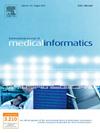使用机器学习识别潜在的医疗援助受益人:韩国全国队列研究。
IF 3.7
2区 医学
Q2 COMPUTER SCIENCE, INFORMATION SYSTEMS
International Journal of Medical Informatics
Pub Date : 2024-12-25
DOI:10.1016/j.ijmedinf.2024.105775
引用次数: 0
摘要
目的:利用个人的人口统计和病史,定性分析重要特征,确定潜在的医疗援助受益人。方法:这项回顾性、国家队列、病例对照研究纳入了2002年1月1日至2019年12月31日期间韩国国民健康保险局(NHIS)的数据。使用几种机器学习模型(线性模型和基于树的模型)对潜在的医疗援助受益人进行分类。收集年龄、性别、地区、保险类型、保险费用等人口统计数据,以及诊断、手术、报表、就诊、费用等病史。这些数据被转换成每个人的一维向量,允许机器学习模型进行学习。对于特征重要性计算,我们使用每个特征的所有分割的平均增益。结果:274,635人最终被纳入研究人群,62,501人被归类为潜在的医疗援助受益人。XGBoost成功地将潜在的医疗援助受益人分类为AUROC约为0.891。假设预测时间在两年之前,其AUROC在0.832左右,表现仍然显著。经济变量,如保险费和其他费用,是最重要的因素,但与医疗状况有关的变量,如血液检查结果和慢性病史,也很重要。结论:基于机器学习的模型成功筛选了潜在的医疗援助受益人。重要特征的定性分析很好地反映了有关公共卫生的先验知识。这些发现有助于医疗保健财务的健全和公共卫生的改善。本文章由计算机程序翻译,如有差异,请以英文原文为准。
Identifying potential medical aid beneficiaries using machine learning: A Korean Nationwide cohort study
Objective
To identify potential medical aid beneficiaries using demographic and medical history of individuals and analyzing important features qualitatively.
Methods
This retrospective, national cohort, case-control study included data from the National Health Insurance Service (NHIS) in Korea between January 1, 2002 and December 31, 2019. Potential medical aid beneficiaries were classified using several machine learning models (linear models and tree-based models). Demographic data such as age, sex, region, insurance type, insurance fee, and medical history such as diagnosis, operation, statement, visits, and costs were collected. Those data were transformed into a one-dimensional vector for each individual, allowing machine learning models to learn. For feature importance calculation, we used the average gain across all splits for each feature.
Results
274,635 individuals were finally included in the study population, and 62,501 were classified as potential medical aid beneficiaries. XGBoost successfully classified potential medical aid beneficiaries with an AUROC of around 0.891. Assuming predicting before two years, the performance was still significant with an AUROC of around 0.832. Economic variables, such as insurance fees and several costs, turned out to be the most important, but variables regarding medical status, such as the results of blood tests and history of chronic diseases, were also important.
Conclusion
Machine learning-based models successfully screened potential medical aid beneficiaries. Qualitative analysis of important features well reflected prior knowledge regarding public health. These findings can contribute to the soundness of healthcare finance and the improvement of public health.
求助全文
通过发布文献求助,成功后即可免费获取论文全文。
去求助
来源期刊

International Journal of Medical Informatics
医学-计算机:信息系统
CiteScore
8.90
自引率
4.10%
发文量
217
审稿时长
42 days
期刊介绍:
International Journal of Medical Informatics provides an international medium for dissemination of original results and interpretative reviews concerning the field of medical informatics. The Journal emphasizes the evaluation of systems in healthcare settings.
The scope of journal covers:
Information systems, including national or international registration systems, hospital information systems, departmental and/or physician''s office systems, document handling systems, electronic medical record systems, standardization, systems integration etc.;
Computer-aided medical decision support systems using heuristic, algorithmic and/or statistical methods as exemplified in decision theory, protocol development, artificial intelligence, etc.
Educational computer based programs pertaining to medical informatics or medicine in general;
Organizational, economic, social, clinical impact, ethical and cost-benefit aspects of IT applications in health care.
 求助内容:
求助内容: 应助结果提醒方式:
应助结果提醒方式:


